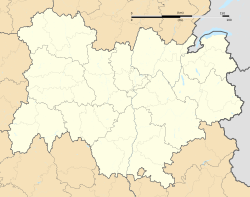|
Revermont
Revermont (French pronunciation: [ʁəvɛʁmɔ̃] ⓘ) is a natural region of France located in the departments of Ain, Jura, and a small portion of Saône-et-Loire. GeographyGeographically defined as the western foothills of the Jura Massif, the Revermont is characterized by limestone relief situated north of the Rhône-Alpes region and southwest of the Jura Massif. It extends from Lons-le-Saunier in the north to the Ain River in the east and the town of Pont-d'Ain in the south. It stretches west to east across the Bresse plain, bordered by Departmental Road 1083 linking Bourg-en-Bresse to Lons-le-Saunier, paralleled by the A39 motorway, towards the Suran Valley and then to the Ain Valley. Dotted with villages, the hillsides of the Revermont extend from Pont-d'Ain to Lons-le-Saunier along the Bresse plain.[1] Sparsely populated, it is a region of low to medium mountains that encompasses typical villages. The viticultural tradition has largely disappeared except on the edge of the Jura near Lons-le-Saunier, and the activity of stone quarries has declined in recent years.[2] Once a land of vineyards, it has preserved numerous stone vineyard houses typical of the region.[3] HistoryToponymyThe term "Revermont" first appeared in 974. It derives its name from "Reversus Montis," meaning "the reverse of the mountain."[4] The region's name has been recorded in various forms over the centuries, including "Reversimontis" in 1084, "Revermont" from 1270, "in Reversomonte" in 1283, "Reversi Montis" in 1289, "Revermontis" in 1304, "in Reversimonte" in 1329, and "Forestas de Reversomonte" in 1416.[5] PrehistoryThe first human traces in the Revermont region date back to around 120,000 years ago. Flint tools, such as arrow and spear points, have been discovered in Ceyzériat, evidencing early human activity.[6] Middle AgesDuring the Middle Ages, the mountains of Revermont marked the western boundary of a vast territory owned by the Coligny family, known as the "Manche des Coligny."[7] In 1283, Robert II, Duke of Burgundy, captured the Revermont region, took Treffort, and proceeded to Bourg where Prince Amadeus was already present.[8] In 1285, Otto IV, Count of Burgundy relinquished his suzerainty over Revermont to Duke Robert II.[9] On August 16, 1285, the Dauphin of Viennois acknowledged the suzerainty of the Duke of Burgundy over Revermont.[10] In 1289, the Duke of Burgundy sold the Revermont to Amadeus V, Count of Savoy for 16,000 livres in silver and 800 livres in land, while retaining the northern part of the region around Cuiseaux.[10] In literatureSeveral writers have settled in the region, including two authors who were awarded the Prix Goncourt in 1957 and 1968:
References
|
||||||||||||||||||
Portal di Ensiklopedia Dunia


